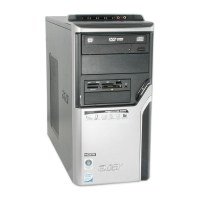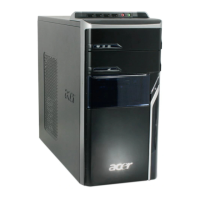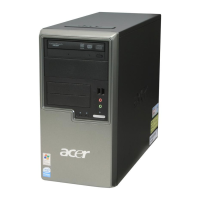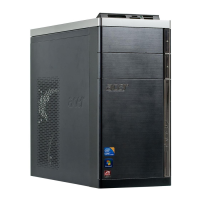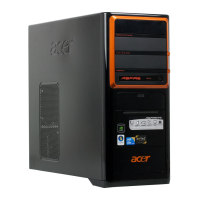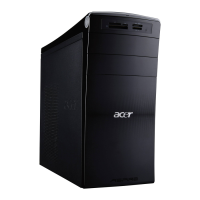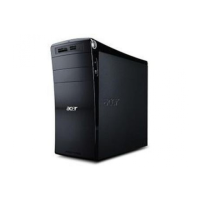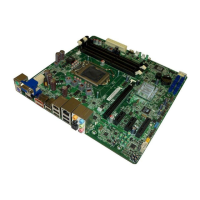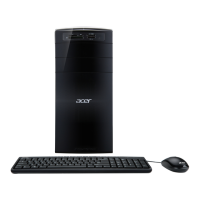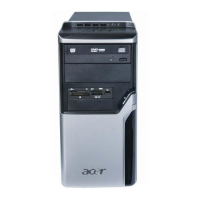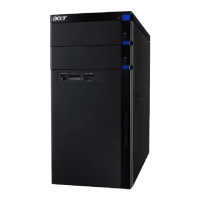Do you have a question about the Acer Aspire M1200 and is the answer not in the manual?
Legal notice regarding reproduction and usage of the publication.
Statement on warranty limitations and Acer's liability for software defects.
Explanation of symbols and terms used throughout the document.
Introduction to the service guide and important notes for users.
Details on OS, Processor, Chipset, Memory, and PCI configurations.
Visual guides for front/rear panels and main board diagrams for different models.
Specifics on Processor, BIOS versions, configurations, and hotkeys.
Information on Memory, Audio, SATA, IDE, Floppy, Parallel, and USB interfaces.
Steps to access and navigate the BIOS setup utility menu.
Information on product details and standard CMOS feature settings.
Settings for advanced BIOS features, chipset options, and peripherals.
Configuration for power saving, PC health monitoring, and frequency settings.
Tools required and general precautions before disassembling the system.
Standard procedures for identifying and labeling components for different models.
Instructions for removing ODD, cards, HDDs, and various cables from the system.
Procedures for removing CPU cooler, memory, CPU, and I/O shielding.
Explanation of jumper types and how to set them for mainboard configuration.
Detailed pinout diagrams for power, fan, and other system connectors.
Information on front panel headers, USB, Audio, 1394, and Aux-In connections.
Visual exploded diagrams identifying chassis components and their part numbers.
| Audio system | High Definition Audio 7.1 |
|---|---|
| Product type | PC |
| Motherboard chipset | AMD 740G |
| Processor cache | 0.512 MB |
| Processor model | 4850e |
| Processor family | AMD Athlon |
| Processor frequency | 2.5 GHz |
| Processor cache type | L2 |
| Processor manufacturer | AMD |
| Internal memory | 2 GB |
| Internal memory type | DDR2-SDRAM |
| Maximum internal memory | 8 GB |
| Memory layout (slots x size) | 2 x 1 GB |
| HDD speed | 7200 RPM |
| HDD interface | SATA |
| Card reader integrated | Yes |
| Total storage capacity | 320 GB |
| Discrete graphics card model | AMD Radeon X2100 |
| Maximum graphics card memory | 0.896 GB |
| Display included | No |
| Bundled software | Microsoft Works 8.5, Adobe Reader 7.0, Acer Arcade Live, Quick Burning (NTI CD-Maker Gold), Acer Empowering Technology |
| Operating system installed | Windows Vista Home Premium |
| Compatible operating systems | Microsoft Office 2007, eSobi v2, 0 Lite |
| PS/2 ports quantity | 2 |
| Serial ports quantity | 0 |
| USB 2.0 ports quantity | 8 |
| Firewire (IEEE 1394) ports | 1 |
| Networking features | Gigabit Ethernet |
| Chassis type | Tower |
| Depth | 441.5 mm |
|---|---|
| Width | 180 mm |
| Height | 359 mm |
